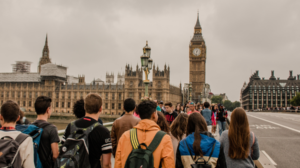Despite my brother’s non-stop jokes before I left for Ireland, nary a leprechaun has been sighted in all the time I have been here. Though I have seen plenty of rainbows given the rainy weather. Not even a whiff of corned beef and cabbage during my four months either. No “top of the morning to ya” to be heard either. What then is left of the American impression of Irish people? Only St. Patrick’s Day, I suppose. Though even this holiday played out a bit differently than the familiar St. Patrick’s Day celebrations. Not surprising when you think about it, but in talking to other American students abroad here, I think our time has concretely illustrated the differences between the Irish and Irish-Americans.
In some ways this can be summarized as the difference between St. Patty’s and St. Paddy’s. Being from Connecticut, I have not made a habit of distinguishing between d and t in the middle of words, but this is apparently a widely-held pet peeve about American English. More than once, Irish friends expressed mystification at the various American hyphen Irish students they encountered who proudly claimed to be Irish without the requisite accent and citizenship. It is interesting to note that Irish-Americans outnumber the Irish by a factor of seven. As you probably know, Boston has the highest number of Irish Americans of any city, with about one-fifth of Bostonians sharing that heritage.
This connection between Boston and Ireland is one reason that I decided to venture to Ireland for a semester abroad. Immigration is a key part of the American history and national sense of self, parallel to Ireland’s history of emigration. In County Cork, just outside the city where I studied, is the port town of Cobh (pronounced “cove”). It was from this port that the majority of Irish emigrants traveled to New York’s Ellis Island, and elsewhere. For anyone in Dublin with the time to visit, EPIC The Irish Emigration Museum is a worthwhile exploration of this history.
Here in the twenty-first century, it is interesting to see which traditions have been maintained on U.S. soil, while others remain only in Ireland. For instance, though Saint Patrick gets all the credit, Ireland actually has three patron saints. The other two being Saint Brigid (or Bríd) and Saint Columba (or Colm Cille). Before there was even a whiff of Saint Patrick’s Day in the air, Saint Bridget’s feast day was observed, the traditional marker of the first day of spring in Ireland…in February.
However, do not get me wrong, there was certainly a Saint Patrick’s Day parade in Cork. It was a frigid, but magical time. It struck me that primarily children were all-out wearing green, excepting the enthusiastic international students. The parade itself passed down the main street of downtown Cork, including Saint Patrick’s Street funnily enough, with dancers, community groups, uniformed soldiers, and church groups in attendance. It was overall calmer than my experiences with the holiday in Boston. Very much a (religious) national holiday, rather than an adopted free for all. However, cultural fusion was evident in the wide range of groups who marched in the parade.
Catholic origins aside, the parade also marked some of the national achievements of the Republic of Ireland. The theme for this year’s parade in Cork City was “Democracy for All – 100 Years of The Vote for Women”, though similar to the suffrage’s passage in the United States one year later, this right was not granted unconditionally to all women. Nonetheless, this theme is one which reflects the Decade of Centenaries, a series of events which commemorate and educate the public about significant events in early 20th century Irish history. These include everything from the Easter Rising which fomented Irish independence to the Ulster Covenant, and significant anniversaries of the first world war.
Outside of Cork City, celebrations great and small signified the festivities. For instance, several towns have made a hilarious competition of inverting “bigger is better,” choosing instead to organize impressively small parades. Though the title is contested, Dripsey in County Cork is one hosts one of the smallest in the country, if not the world. The entire route is a 25-yard trek between two pubs. Cork’s annual parade attracted a respectable 50,000 people. However, it was about 450,000 who swarmed the streets of Dublin. In contrast, somewhere between 600,000 and 1 million people attended Boston’s own Saint Patrick’s Day parade.
No matter the size, it was incredible to have experienced an “authentic” Saint Patrick’s Day. In the end, celebrations in the United States also celebrate something authentic, the evolving tradition of diaspora communities. Being able to recognize that by experiencing the Saint Patrick’s Day in Ireland is unforgettable.










